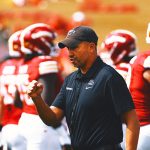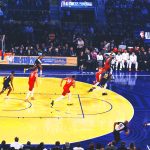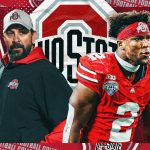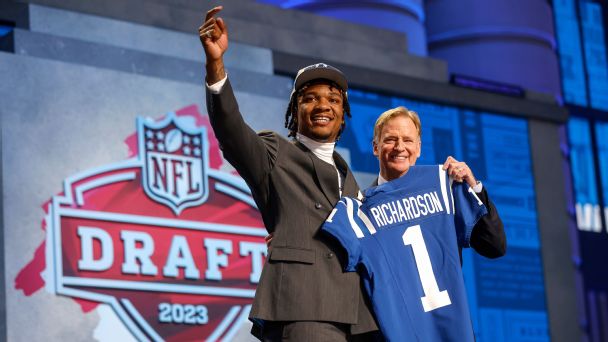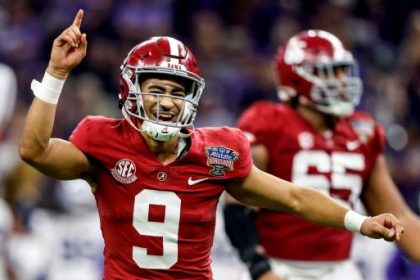
April has become increasingly busy for college football coaches.
Finishing spring practice, hosting recruits, hitting the road to see prospects or just monitoring the spring transfer portal window, which closed at midnight Monday.
But college coaches still had time to track the NFL draft, not only what happened with their own players but with the ones they faced over the past few seasons.
College coaches have a distinct perspective on draft prospects. They have followed many since high school, and then recruited or game-planned for them over the past few years. After launching the draft reaction piece in 2021 and following up in 2022, I contacted more than 30 college coaches in recent days to gather their thoughts on the draft. I spoke mostly to head coaches and coordinators in the Power 5, but also some Group of 5 coaches, to break down who went where and why.
They came away with thoughts — on the first-round surprises, the quarterbacks, best fits for players/teams, the overall outputs for college programs and, of course, sleepers.
Most coaches spoke anonymously.
Here’s an evaluation of the 2023 NFL draft through the eyes of college coaches (Note: Coaches are listed according to their roles during the 2022 season).
Jump to:
QBs | First round
Second round | Coaches dish
Sleepers

QB debates: Richardson, Levis, Hooker and others
2:39
Harry Douglas: Colts’ QB-run game will be on point with Richardson
Harry Douglas reacts to the Colts taking Anthony Richardson with the fourth pick and what it means for their offense.
Despite some pre-draft chatter, the top quarterbacks off the board went as expected: Alabama’s Bryce Young at No. 1 overall to Carolina, followed by Ohio State’s C.J. Stroud at No. 2 to Houston. Then, the drama began, as Florida’s Anthony Richardson went No. 4 to Indianapolis, despite starting only 13 games for the Gators and lacking the statistics of a typical top-five pick.
“He’s a great talent, and if they can get him to improve the accuracy and the decision-making, then he’ll turn out to be incredible,” said a defensive coordinator who faced Richardson last season.
Coaches thought that despite the high pick, Indianapolis made a lot of sense for Richardson, as new coach Shane Steichen developed Jalen Hurts into a Pro Bowler with the Philadelphia Eagles.
“I love the Colts taking him because of the scheme,” an SEC coordinator said. “They’ll let him get outside the pocket. He’s like a bigger version of Mike Vick.”
Another Power 5 defensive coordinator added: “It’s a college system. [Steichen is] trying to rinse and repeat what he did with Hurts.”
Kentucky’s Will Levis also had been pegged as an option for the Colts, and seemed likely to hear his name called soon after Richardson’s. But after attending the first night of the draft in Kansas City, he left without an NFL home, before the Tennessee Titans selected him with the second pick of the second round.
Levis had been widely projected in the first half of the first round, but his drop didn’t surprise coaches in the SEC and others who faced him.
“It’s just the second round, not like [Day 3],” an SEC defensive coordinator said. “He was crowned last year at this time to be the top pick, without a lot of research. He’s talented, but not first-pick talented.”
An SEC offensive coordinator thought Levis going ahead of Tennessee’s Hendon Hooker (third round, No. 68 overall) was “shocking.”
Levis threw for 43 touchdowns in two seasons at Kentucky but also had 23 interceptions. “Your No. 1 job as a quarterback is to take care of the football,” the coach said.
An SEC defensive coordinator noted that Levis was much better in 2021, when he played behind a strong offensive line and had an elite playmaker in wide receiver Wan’dale Robinson. Kentucky’s coordinator switch from Liam Coen to Rich Scangarello also seemingly worked against him.
Coaches generally had a positive view of Hooker but noted he thrived in a system that doesn’t always translate to the NFL. A defensive coordinator who faced Tennessee said Hooker struggled with overthrows on routes breaking toward the middle of the field.
“You throw balls high on those routes in the NFL, it’s either going to be picked or you’re going to get kill shots,” the coach said.
BEST OF THE REST
Stetson Bennett: While Levis and Hooker went a bit later than expected, Georgia’s Bennett’s wait ended in the fourth round as the Los Angeles Rams selected him with pick No. 128. Bennett led Georgia to the past two national championships but lacks prototypical NFL size and will turn 26 in October.
“Stetson will be a good backup,” an SEC defensive coordinator said. “He’s going to be like Chase Daniel, just a journeyman, make a career of it in the NFL, or [former Rams backup] John Wolford.”
An SEC offensive coordinator added: “It’s the same thing with Brock Purdy a year ago. Stetson Bennett is a winner. I know measurables-wise, it doesn’t work.”
From a Power 5 defensive coordinator: “I studied some defenses against Georgia and Stetson Bennett is dismissed as a game manager, but almost all the film shows him as the catalyst.”
Jake Haener: A similar description applies to Fresno State’s Haener, who went one spot ahead of Bennett, to New Orleans with pick No. 127. The 6-foot-1 Haener, who began his career at Washington, had 9,013 passing yards and 67 touchdowns over the past three seasons at Fresno State, helping the team to a Mountain West championship last fall.
“He’s got an extremely good arm, he’s really accurate,” a Mountain West defensive coordinator said. “The knock on him is his overall size, but then you’ve got the No. 1 pick in the draft [Young], who’s not as big.”
A Pac-12 defensive coordinator said: “I watched a lot of tape on Haener from Fresno. He is outstanding.”
Aidan O’Connell: Purdue’s O’Connell capped the fourth round, going to the Las Vegas Raiders. Coaches love O’Connell’s accuracy, release and field vision, but noted his lack of mobility doesn’t translate to what the NFL now asks of QBs.
“He’ll be a really long-term, good backup, he’ll play forever,” a Big Ten coach said. “He’ll wear a ballcap, hold a clipboard, make a lot of money. He’s so smart and he’s really accurate. But there aren’t many statues anymore [at quarterback].”
Tanner McKee: He was one of five Stanford players drafted, despite a team that went 3-9. McKee, who went to the Eagles in Round 6, has impressive size at 6-foot-6 and 231 pounds, and had 5,274 passing yards and 28 touchdowns the past two seasons.
“I know he’s got arm talent, but post-snap movement, stuff like that, he really struggled,” a Pac-12 defensive coordinator said. “It will be interesting to see how he does at the next level.”
First-round takeaways: Jalen Carter, Lions, WRs delayed
The first round produced plenty of storylines beyond the quarterbacks, especially around the selection of Georgia’s Jalen Carter. No non-quarterback generated more attention going into the draft than the Bulldogs’ defensive tackle. Some coaches saw Carter as the single biggest factor in the team’s back-to-back national championships, and potentially the most talented player on the draft board.
“I don’t know if there was a more dominant player I saw,” an SEC offensive coordinator said. “He can change a game from the D-tackle spot. I don’t know who the last one was from the 3-technique, maybe Aaron Donald. He was the difference for [Georgia]. If I was building a team straight out of talent, he’s where I look.”
Concerns about Carter dropped him to No. 9 overall with the Philadelphia Eagles, behind three other defensive players. In March, Carter pleaded no contest to misdemeanor charges of reckless driving and racing connected to a January crash that killed teammate Devin Willock and Georgia recruiting staffer Chandler LeCroy. Carter was sentenced to 12 months of probation, a $1,000 fine and 80 hours of community service and will attend a state-approved driving course.
Several picks that followed Carter generated reaction, including the Detroit Lions taking Alabama running back Jahmyr Gibbs at No. 12 and Iowa linebacker Jack Campbell at No. 18.
A Power 5 head coach joked that he thought middle linebackers couldn’t get drafted in the first round anymore, adding that Campbell could fade on third downs. But Campbell shined in the middle of Iowa’s defense, recording 265 tackles, four interceptions and two forced fumbles in his last two seasons. He also has notable size at 6-foot-5 and 249 pounds.
“For an inside ‘backer in today’s game, it’s rare to have one that tall and with his combination of speed,” a Big Ten coach said. “He’s built more like the ones in the ’80s, a 6-4 guy, but he can run. An absolute stud.”
Another Big Ten coach added: “For teams that really want a communicating inside linebacker, they’re just hard to get. I think that kid’s special.”
Campbell wasn’t the only first-round selection from Iowa who generated some buzz. Defensive end Lukas Van Ness went at No. 13 to Green Bay, giving the team a proven pass-rusher with 13.5 sacks the past two seasons … but zero starts.
“When’s the last time a guy got picked in the top 20 and didn’t start a game?” a Big Ten coach said. “He’s 6-6 and he’s athletic, there’s no doubt about that.”
Another coordinator who faced Iowa added, “That kid was one of the most disruptive players we played against. He just only played 25 snaps.”
Coaches liked Tampa Bay’s draft overall, which began with Pitt defensive tackle Calijah Kancey. Only 6-foot-1 and 281 pounds, Kancey led FBS defensive tackles with 7.5 sacks last season, while earning unanimous All-America honors.
“That nose tackle, he’s small but he’s really good,” an ACC coach said. “Very disruptive, very twitched up. He’s just smaller.”
The first round featured selections of four offensive tackles, three cornerbacks, three quarterbacks, two outside linebackers, two defensive tackles, two defensive ends, two running backs and an inside linebacker before the first wide receiver: Ohio State’s Jaxon Smith-Njigba to Seattle at No. 20. Smith-Njigba began a stretch of four straight receivers, but the string of wideouts was delayed compared to 2022, when six went among the first 18 selections.
In 2021, three receivers went in the top 10.
“A little surprising, given what the game is these days,” a Power 5 offensive coordinator said. “You want a No. 1, No. 2 receiver, that costs you $20 million a year. You can get these [draft picks] for $20 million for four years. Some teams that needed receivers didn’t make moves.”
Among the four receivers in the first round, coaches were most bullish on Boston College’s Zay Flowers, who had 78 receptions last season and 27 career touchdown receptions.
“Really good,” an ACC coach said. “He’s got great speed. He had some questionable hands at times, but man, he could run. He ran by some pretty good corners in this league.”
USC’s Jordan Addison, the 2021 Biletnikoff Award winner while at Pitt, went just behind Flowers to Minnesota at No. 24. A Pac-12 defensive coordinator mentioned former Green Bay Packers star Donald Driver as a potential NFL comparison for Addison, who shined against zone coverage but “never blew me away.”
“I would much rather face Addison than JuJu [Smith-Schuster] or Robert Woods, Marqise Lee, some of these other wideouts that USC has had,” a Pac-12 coach said. “The others could physically mess with you. They were just bigger bodies. Addison is smooth and has really good speed and really good hands. Those other guys just scared me more.”
Porter and tight ends headline intriguing second round
0:42
The plays that made the Steelers draft Joey Porter Jr.
Check out the highlights from Penn State corner Joey Porter Jr.
Coaches had plenty to say about the second-rounders, beginning with the first player selected, Penn State cornerback Joey Porter Jr., who went to Pittsburgh.
Several coaches thought Porter, a second-team All-America selection who stands 6-foot-2 and plays with an aggressive style, was snubbed by having to wait until Day 2.
“He’s just so long,” a Big Ten coach said. “Not very many corners are built like that. You don’t see that kind of length.”
Utah’s Dalton Kincaid (No. 26, Buffalo) was the only tight end selected in the first round, but four went in the second round, beginning with Iowa’s Sam LaPorta (Detroit) and Notre Dame’s Michael Mayer (Las Vegas) back to back. Opposing coaches singled out LaPorta’s run-after-catch ability and noted both he and Mayer produced throughout their careers despite lacking great wide receivers around them.
Oregon State’s Luke Musgrave (Green Bay) went a few spots behind Mayer despite missing all but two games because of injury in 2022. Musgrave’s size (6-foot-6, 253 pounds) and production, when healthy, jumped out. A Pac-12 defensive coordinator described Musgrave as “a throwback,” noting that he didn’t stand out as a pass-catcher but can be used in many ways.
“Teams are going to use him as a down tight end and muscle people,” another Pac-12 defensive coordinator said. “He’s more than adequate as a receiving tight end. He’s not going to wow you in space, but he’s a heck of a player.”
UCLA’s Zach Charbonnet (Seattle) was the only running back to hear his name called in the second. Charbonnet, who began his career at Michigan, showed consistency throughout his Bruins career, especially last season, when he eclipsed 75 rushing yards in every game, topped 100 in eight contests and made 37 receptions.
“He got better and better and better,” a Pac-12 defensive coordinator said. “He was one of the better players in the Pac-12 by the end.”
The second round included a run on Big Ten centers, but the order of selections was notable. Wisconsin’s Joe Tippmann went first at No. 43 overall to the Jets. Fourteen spots later, the Giants selected Minnesota’s John Michael Schmitz, considered by many as the top center prospect in the draft. The Texans made the penultimate pick of the round and went with Penn State’s Juice Scruggs, who started the past two seasons.
“You don’t hear of centers that big,” a Big Ten defensive coordinator said of Tippmann, who is 6-foot-6 and 313 pounds. “Wisconsin’s recent centers have been pretty normal sized. I don’t know how well you can move at 6-6 playing center. He doesn’t fit that cookie-cutter profile for that position, but does he have any flexibility to play the guard positions?”
Coaches dish on Illinois, Florida and TCU
0:35
Newest Seahawk Devon Witherspoon’s best plays from Illinois
Check out the highlights from Illinois corner Devon Witherspoon as the Seahawks draft the CB at No. 5.
The draft featured sizable groups from perennial picks producers like Georgia (10 selections), Alabama (10), Michigan (9), Ohio State (6) and Clemson (6). But other teams also stood out for their draft groups.
![]()
Illinois: After finishing No. 1 nationally in scoring defense last season, Illinois had an excellent draft output. Cornerback Devon Witherspoon went No. 5 to Seattle, the first Illini selected in the top five since 1996. Safeties Jartavius Martin and Sydney Brown went in the second and third rounds, respectively, making Illinois the only team to have three defensive backs selected in the first three rounds.
Illinois had never seen three of its defensive backs drafted in the same year since the AFL-NFL merger. Running back Chase Brown, Sydney’s twin, went in the fifth round, as they become the sixth set of twins taken in the same draft.
“I was not surprised,” a Big Ten coach said. “We thought those three [defensive backs] for Illinois were as good as you’re going to see in the country, and they were. Just the size and toughness and cover ability, those guys can cover and they can play zone.”
Several coaches credited coach Bret Bielema, former defensive coordinator Ryan Walters (now Purdue’s coach) and the Illinois staff for the draft group, but also noted that former coach Lovie Smith deserved some praise. Smith, an accomplished NFL defensive mind who struggled at Illinois (17-39), recruited Witherspoon, Martin and the Browns.
“You’ve got to tip your hat to Lovie,” a Big Ten coordinator said. “Those are all Lovie’s guys. That was a talented group that just got drafted. They played them all so young. It paid off for Illinois. It didn’t pay off for Lovie.”
Illini defenders at the top of the draft might not be a one-year thing, either. Defensive tackle Jer’Zhan Newton is a first-round pick according to the initial 2024 mock draft by ESPN’s Todd McShay.
![]()
Florida: Not surprisingly, Georgia and Alabama produced more draft picks than any FBS teams. They headlined an SEC draft haul that included 12 teams with multiple draftees. But Florida somewhat surprisingly tied for fifth nationally with six picks, headlined by Richardson but also including two second-round picks in defensive tackle Gervon Dexter and offensive guard O’Cyrus Torrence.
But last year’s team went 6-7. The Gators were the only team with six or more draft picks that had a losing record.
“It’s an interesting situation to study,” an SEC coordinator said. “You can say coaching or whatever you want, but [Billy] Napier at [Louisiana] Lafayette was a phenomenal coach. Are there other factors that don’t allow a team like that to win? How many guys can you draft on potential? How do you have three guys drafted off a defense that was one of the worst in the country?”
Florida finished 96th in total defense and 86th in points allowed last season. Still, coaches liked linebacker Ventrell Miller, who went in the fourth round to Jacksonville. Torrence, who followed Napier from Louisiana to Florida, also drew good reviews.
“He’s a mauler,” said a defensive coordinator who faced Florida. “He’s a big, physical player, really good.”
![]()
TCU: After reaching the national championship game under first-year coach Sonny Dykes, TCU led the Big 12 with eight players drafted, including selections in each of the first three rounds. TCU’s draft class marked its biggest since the seven-round format was instituted (the team also had eight selections in 1958, when the draft spanned 30 rounds).
The Frogs produced the second wide receiver drafted in Quentin Johnston (Chargers) and the first interior offensive lineman off the board in Steve Avila (Rams). Five offensive players heard their names called, including quarterback Max Duggan (Chargers), the Heisman Trophy runner-up, who went midway through the seventh round. TCU also had three defenders drafted.
“I guess there was a reason they ended up going to the playoff,” a Big 12 defensive coordinator said. “They looked different than they normally did. They had guys who played a lot of ball. I knew the receiver and the running back [Kendre Miller] are really good players. Duggan is a gutty competitor. Avila is a really good player.”
Miller (Saints) was the fourth running back drafted after a breakout season in which he had 1,399 rushing yards, becoming TCU’s first 1,000-yard rusher since 2016.
“He was a real guy,” a Big 12 defensive coordinator said. “Had he not gotten hurt and been a little more significant part of that [College Football Playoff] run they were on, that could have helped him.”
TCU cornerback Tre’Vius Hodges-Tomlinson, who won the Jim Thorpe Award as the nation’s top defensive back in 2022, went early in the sixth round to the Los Angeles Rams. Hodges-Tomlinson was one of the most accomplished defenders in team history, earning All-Big 12 honors three times and All-America honors twice.
But at 5-foot-8 and 178 pounds, Hodges-Tomlinson doesn’t fit the NFL’s preference for taller cornerbacks.
“He’ll be fine,” a Big 12 coordinator said. “He makes up for his physical deficiency.”
Coaches make sleeper picks
College coaches are often proudest of their developmental players — unheralded recruits who evolve into stars. They recognize the same process takes place with the NFL draft, as teams use the final four rounds to identify players who are lacking in some areas but could turn into capable pros and even stars.
Here are some their sleeper picks from Rounds 3-7:
![]()
Arkansas linebacker Drew Sanders (third round, Denver): Sanders, who transferred from Alabama, had a blistering start to the 2022 season and finished with noteworthy numbers. He tied for the SEC lead in sacks (9.5) while leading Arkansas in tackles for loss (13.5), forced fumbles (3) and total tackles (103).
Sanders showed his effectiveness against both the run and the pass but likely slipped below several linebackers because he primarily plays on the inside.
“Maybe people were confused. Is [Sanders] a jack of all trades and a king of nothing? Are you an inside guy? Are you a stack ‘backer? Are you a D-end?” a Power 5 coordinator asked. “I think he’s a really good player.”
![]()
Houston wide receiver Nathaniel Dell (third round, Houston): Dell is far from an unknown in the city of Houston, where he shined for the Cougars the past three seasons. He led Houston in receiving in all three years he played, and last fall led the FBS in receiving yards (1,398), receiving touchdowns (17) and games with multiple touchdown catches (6).
Dell is just 5-foot-8 and 165 pounds, though, and his size likely turned off several teams with receiving needs.
“If he can get off press [coverage] in the league, that will be his big deal,” an AAC defensive coordinator said. “If [opponents] can get their hands on him within that 5 yards, he’ll have problems, but if he can handle that, he’ll be fine.”
![]()
Tennessee wide receiver Cedric Tillman (third round, Cleveland): Although coaches noted the potential challenges for Tennessee players transitioning to NFL offenses, they liked Tillman, even more so than the player drafted right before him, fellow Vols wideout Jalin Hyatt. Although Hyatt won the Biletnikoff Award and finished fifth nationally in receiving yards, Tillman made his mark when healthy last season and through 2021, when he became Tennessee’s first 1,000-yard receiver since Justin Hunter in 2012.
“Tillman’s got better hands,” an SEC defensive coordinator said. “Hyatt, when he was wide open, they could use his speed. They did a great job of creating open receivers. When he had to make contested catches, he struggled. Tillman will do a good job. Those big, physical guys do well.”
Another Power 5 coordinator added: “His route tree’s bigger. He’s just got more to offer.”
![]()
North Carolina wide receiver Josh Downs (third round, Indianapolis Colts): Several coaches both inside and outside the ACC mentioned Downs as a receiver they thought would go higher than 79th overall. Downs ranks in the top five on North Carolina’s career lists for receptions (202), receiving yards (2,483) and touchdowns (22). An ACC coach said the Air Raid/up-tempo offense Downs played in at UNC, while productive, might have impacted his draft placement.
“He’s really smooth and he’ll be a good pro,” another ACC coach said.
Added another Power 5 defensive coordinator: “He could be the steal of the draft.”
![]()
Tulane running back Tyjae Spears (third round, Tennessee Titans): Spears entered the national spotlight during Tulane’s incredible 2022 season, which culminated with a Cotton Bowl championship. He finished fifth nationally in rushing yards (1,581) and tied for third in rushing touchdowns (19).
Spears’ history of knee problems — he twice has suffered ACL tears — pushed him to midway through the third round. But he had “legit speed and shake,” a Power 5 coordinator said.
“He’s thicker than you give him credit for,” an AAC defensive coordinator said of the 5-foot-10, 201-pound Spears. “He’s put together. He’ll protect on pass downs. A tough, hard-nosed kid.”
![]()
Clemson linebacker Trenton Simpson (third round, Baltimore Ravens): Linemen Myles Murphy and Bryan Bresee were Clemson’s defensive headliners and became consecutive first-round selections at Nos. 28 and 29 to the Bengals and Saints, respectively. But Simpson impressed coaches in the ACC after recording 164 tackles, 22.5 for loss, and three forced fumbles in three seasons.
An ACC coach was surprised to see Simpson last until the third round.
“Strong, very athletic, I thought he could run,” another ACC coach said. “He seemed very instinctive.”
![]()
![]()
Cincinnati wide receivers Tre Tucker (third round, Las Vegas Raiders) and Tyler Scott (fourth round, Chicago): Cincinnati finished 54th nationally in pass offense last season, but Tucker and Scott both jumped out to opposing coaches. The Bearcats tandem combined for 104 receptions and 1,571 receiving yards.
An AAC coach noted Scott dealt with some injury issues at Cincinnati but “can really roll, he can fly.”
“They can just pull away,” an AAC defensive coordinator said. “They were both 4.4 at the combine, and it showed in games.”
![]()
Old Dominion offensive tackle Nick Saldiveri (fourth round, New Orleans Saints): Saldiveri came to Old Dominion under the previous coaching staff and would become an all-conference player in two leagues (Conference USA, Sun Belt). The Saints gave up a fifth-round pick to move up 11 spots in the fourth round to take Saldiveri.
“The Saints trading up to get Nick says a lot about what they thought,” Old Dominion coach Ricky Rahne said.
![]()
Georgia cornerback Kelee Ringo (fourth round, Philadelphia Eagles): Several coaches both within and outside the SEC took note of Ringo’s selection, especially for a former ESPN top-10 recruit who started for Georgia’s national championship-winning defenses. Ringo recorded two interceptions in each season and finished his college career with 19 passes defended.
He earned second-team All-SEC honors last fall. An SEC coordinator said Ringo lacked the fluidity of several defensive backs who went earlier, but that he still brought a lot to Georgia’s defense.
“I was surprised,” an SEC coach said. “He was a really good player. He dominated Ohio State [in the CFP semifinal].”
![]()
Wisconsin linebacker Nick Herbig (fourth round, Pittsburgh Steelers): The Steelers have a good history with Wisconsin players (hello, T.J. Watt) and added two Badger defenders in the first four rounds in nose tackle Keeanu Benton and Herbig, a third-team All-America selection and a consensus first-team All-Big Ten pick. Herbig had 20 sacks, 30 tackles for loss and four forced fumbles in his final two seasons with Wisconsin.
“I really liked Herbig,” a Big Ten coach said. “Everybody says, ‘What’s the best value?’ That guy’s a good one. He’s not real flashy, just gets stuff done and Pittsburgh, they know it.”
![]()
Oregon linebacker Noah Sewell (fifth round, Chicago Bears): A year ago, Sewell was pegged to be one of the top inside linebackers off of the board. In 2021, he became the first Oregon player ever named a semifinalist for the Butkus Award (nation’s top linebacker).
“Shocked,” a coach familiar with Sewell said. “He was supposed to be a first-day guy.”
Sewell’s numbers regressed last season, but he still earned second-team All-Pac-12 honors and finished with 215 career tackles, including 19.5 for loss, and 7.5 sacks, two interceptions and three forced fumbles.
“Sewell’s a problem, he’ll stick somewhere,” a Pac-12 coordinator said. “Ideally, he needs to be in a 3-4 [alignment].”
![]()
Michigan center Olu Oluwatimi (fifth round, Seattle Seahawks): He won the Rimington Trophy as the nation’s top college center, and helped Michigan return to the CFP behind a run game that ranked fifth nationally in yards per game and second in rushing touchdowns. But Oluwatimi surprisingly was the sixth center drafted and the fourth from the Big Ten. One Big Ten coach thought Oluwatimi and Schmitz (second round) were comparable prospects.
A Big Ten defensive coordinator said Oluwatimi likely was hurt by some “stiffness” in his play, and solely playing center on the line.
“We had as much respect for Olu as we did anybody in the league,” the coach said. “But when it comes to the NFL, it’s a little bit different projection.”
![]()
Nebraska wide receiver Trey Palmer (sixth round, Tampa Bay Buccaneers): Nebraska struggled for much of last season, but Palmer, a transfer from LSU, made his mark with a team-record 1,043 receiving yards. The second-team All-Big Ten selection finished third in the Big Ten in receiving yards, receptions (71) and touchdown catches (9).
Although he finished fourth in the 40-yard dash at the NFL combine (4.33 seconds), Palmer waited until pick No. 191 to hear his name called.
“He can run,” a Big Ten defensive coordinator said. “That offense was up and down, especially with the quarterback situation, and there was a lot of turmoil there, but I thought he was one of the better players we saw all year.”
![]()
Kentucky running back Chris Rodriguez Jr. (sixth round, Washington Commanders): Much like his backfield mate Levis, Rodriguez had a rosier draft outlook after the 2021 season, when he earned first-team All-SEC honors while averaging 106.1 yards per game. He was suspended for the first four games this past season, and finished with 904 rushing yards and six touchdowns in eight contests (seven starts).
Coaches like Rodriguez’s 217-pound frame and think he can have a solid pro career in the right offense.
“Real good player,” a Power 5 defensive coordinator said. “He’s got some sturdiness to him that’s going to be required at the next level. He’s a good-sized kid.”
Added an SEC coordinator: “Not a superstar, but he can be productive.”
![]()
Kansas State running back Deuce Vaughn (sixth round, Dallas Cowboys): At 5-foot-5, he measured as the shortest player at the NFL combine since 2003. But the two-time consensus All-America selection had 5,029 career all-purpose yards and 29 career games with at least 100 yards from scrimmage.
He also shined in two career games at AT&T Stadium, the Cowboys’ home, recording 296 yards from scrimmage in wins over Stanford and TCU in the 2022 Big 12 title game.
“The story and watching that with his dad was awesome, but I was disappointed he went in the sixth round,” a Power 5 defensive coordinator said. “He’ll be productive. He’s really good.”
Said another Power 5 defensive coordinator: “Deuce Vaughn is size deficient, but he doesn’t seem to care, so I doubt he’ll start caring now! He is a scary matchup, specifically in pass game versus linebackers.”
![]()
Central Michigan running back Lew Nichols III (seventh round, Green Bay Packers): The 222-pound Nichols led the FBS in both rushing yards (1,848) and carries (341) in 2021 while tying for 10th in rushing touchdowns (16). Injuries limited him last season and his numbers dropped off, but he still finished with 3,061 career rushing yards at CMU, where he won MAC Freshman of the Year honors in 2020.
“He had the production and he has the build,” a MAC coach said. “He looks like an NFL back. He’s not as athletic, but he looks like Tony Pollard. They’re built the same way.”

